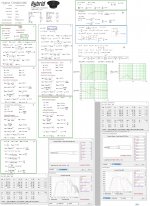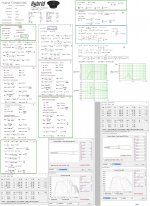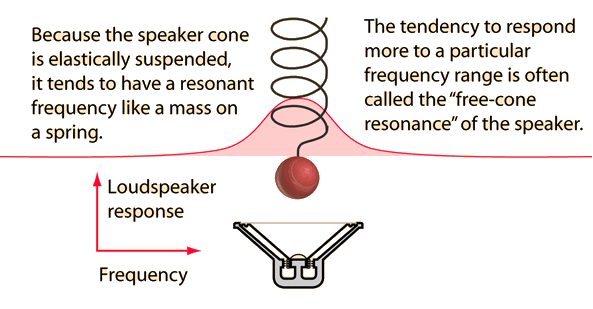I acquired an 8" passive sub a long while ago, and I built a 2x50W amp into a new enclosure with the same dimensions as the previous one so now it's active. It gives me good results - it's really impressive for a no-namer, but I want something to complement my Celestion F20's better.
I recently completed the electronics of a 4 channel amplifier for bi-amping my speakers, and I get excellent volume and quality out of them, but I've always wanted that in-your-face, move-the-room, shake-the-earth bass. A friend of mine has an Energy 8", which is mind-blowing. I want similar pounding bass.
I've always loved and wanted huge lows, but I've never had the capability to put out strong SPL's below 35 Hz. Where do I start? I have a 140 W amplifier (currently in an unsuccessful bass amplifier), and it powers 8 ohms. I have two 4 ohm 10" car subs - is it at all possible to use them to good effect, or do I need a better driver?
I also have a 2 x 140 W amplifier which I can sacrifice to power 2 drivers (8 ohm each though).
I live in South Africa, so if anyone knows cost-effective drivers around here, that would be most appreciated!
ETA: I'm looking for high-quality for music and movies.
I recently completed the electronics of a 4 channel amplifier for bi-amping my speakers, and I get excellent volume and quality out of them, but I've always wanted that in-your-face, move-the-room, shake-the-earth bass. A friend of mine has an Energy 8", which is mind-blowing. I want similar pounding bass.
I've always loved and wanted huge lows, but I've never had the capability to put out strong SPL's below 35 Hz. Where do I start? I have a 140 W amplifier (currently in an unsuccessful bass amplifier), and it powers 8 ohms. I have two 4 ohm 10" car subs - is it at all possible to use them to good effect, or do I need a better driver?
I also have a 2 x 140 W amplifier which I can sacrifice to power 2 drivers (8 ohm each though).
I live in South Africa, so if anyone knows cost-effective drivers around here, that would be most appreciated!
ETA: I'm looking for high-quality for music and movies.
Last edited:
Would this work well?
An externally hosted image should be here but it was not working when we last tested it.
Would this work well?
An externally hosted image should be here but it was not working when we last tested it.
No. But those 10" car subs might, if you have the parameters for them available.
Hi,
You start with the specifications of the 10" car subwoofers.
Though if typical car specs they will work best in about 1.5 cuft
for both, sealed and stuffed, with the drivers on left and right
faces for some force cancelling, but you really need specs.
rgds, sreten.
That 12" is a nonstarter for a sub, Fs is way too high.
You start with the specifications of the 10" car subwoofers.
Though if typical car specs they will work best in about 1.5 cuft
for both, sealed and stuffed, with the drivers on left and right
faces for some force cancelling, but you really need specs.
rgds, sreten.
That 12" is a nonstarter for a sub, Fs is way too high.
Last edited:
Thanks for the replies! I recently acquired a scope, so I'll do some measuring. I'm sure a scope will make it easy to measure.
What parameters should I measure? Maybe Fs, and if it's too high, pack it up? Am i looking for Fs=30Hz or so? What else should I measure?
Qes and Vas?
What parameters should I measure? Maybe Fs, and if it's too high, pack it up? Am i looking for Fs=30Hz or so? What else should I measure?
Qes and Vas?
Hi,
Fs, Qts and Vas are all you need you need to design a
box. No such thing as too high an Fs for a subwoofer.
rgds, sreten.
Fs, Qts and Vas are all you need you need to design a
box. No such thing as too high an Fs for a subwoofer.
rgds, sreten.
No such thing as too high an Fs for a subwoofer.
.
In as much as that is contrary to accepted wisdom, do you feel we are worthy of an explanation of what you just might mean?
Ben
In as much as that is contrary to accepted wisdom, do you feel we are worthy of an explanation of what you just might mean?
Ben
Whose accepted wisdom?
It's pretty simple really.
If the box is sealed and the f3 is too high you can eq the response curve to any shape and any qtc and any f3 you want.
If the box is ported (or mltl or tl, etc) a high fs will just give you a rising response, this often works very well to match the inverse of the room gain curve for a summed flat(ish) in room response. And of course you can eq to any response you like.
If the box is a horn a high fs is usually very beneficial, certainly higher than the horn's low knee. For a tapped horn a fs up to 2x higher than the low knee can still give a flat(ish) response.
I'm sure you've seen this picture a few times now, it's a tapped horn with a 6 inch driver I built in 2009. What do you think the fs of the driver is? I'll give you a hint. It's 47.35 hz. This is measured response, not a sim. So you see it's pretty basic. High fs isn't really a problem, there are other far more important considerations.
An externally hosted image should be here but it was not working when we last tested it.
Hi All,
FYI:
b🙂
Ops! Posted a BR FR plot using a Box Volume too small 😱
Discard the Picture here above and replace with:
b🙂
Attachments
Whose accepted wisdom?
It's pretty simple really.
If the box is sealed and the f3 is too high you can eq the response curve to any shape and any qtc and any f3 you want.
If the box is ported (or mltl or tl, etc) a high fs will just give you a rising response, this often works very well to match the inverse of the room gain curve for a summed flat(ish) in room response. And of course you can eq to any response you like.
If the box is a horn a high fs is usually very beneficial, certainly higher than the horn's low knee. For a tapped horn a fs up to 2x higher than the low knee can still give a flat(ish) response.
I'm sure you've seen this picture a few times now, it's a tapped horn with a 6 inch driver I built in 2009. What do you think the fs of the driver is? I'll give you a hint. It's 47.35 hz. This is measured response, not a sim. So you see it's pretty basic. High fs isn't really a problem, there are other far more important considerations.
An externally hosted image should be here but it was not working when we last tested it.
You should take care to the membrane self ringing, some cones are ringing a lot at their Fs and equalizations can't solve that.
Not sure what you are referring to. The driver is not a high qts driver the cone is very small (6 inches) and strong and the bump in the measurement is a natural transmission line resonance.
There's no ringing problems here.
There's no ringing problems here.
Not sure what you are referring to. The driver is not a high qts driver the cone is very small (6 inches) and strong and the bump in the measurement is a natural transmission line resonance.
There's no ringing problems here.
Time resonance (CSD)
"Originally Posted by sreten
No such thing as too high an Fs for a subwoofer."
Hi,
I have no idea what I actually meant to say,
but I certainty did not mean to say that.
I said in a post further up the 12" is a not
a good choice as its Fs is way too high.
rgds, sreten.
No such thing as too high an Fs for a subwoofer."
In as much as that is contrary to accepted wisdom, do you feel
we are worthy of an explanation of what you just might mean?
Ben
Hi,
I have no idea what I actually meant to say,
but I certainty did not mean to say that.
I said in a post further up the 12" is a not
a good choice as its Fs is way too high.
rgds, sreten.
Last edited:
"Originally Posted by sreten
No such thing as too high an Fs for a subwoofer."
Hi,
I have no idea what I actually meant to say,
but I certainty did not mean to say that.
I said in a post further up the 12" is a not
a good choice as its Fs is way too high.
rgds, sreten.
The fs is fine. It will give a high f3 in a closed box and a rising response in a ported type box. There's no problem with that, as presumably eq is going to be needed anyway to sort out room issues.
For a 30 or so hz horn the 69 hz fs is just about ideal.
The much bigger problem with that driver is the very low 6 mm xmax.
Time resonance (CSD)
This driver doesn't have any time resonance issues related to fs that other drivers don't have, in fact probably less. It's not a high qts driver and ringing at fs is simply not an issue.
Ok, i just try to share my experience.
What are you getting at? What do you recommend doing different? How do you suggest that I take care of the membrane self ringing?
- Status
- Not open for further replies.
- Home
- Loudspeakers
- Subwoofers
- Subwoofer build - where do I start?


